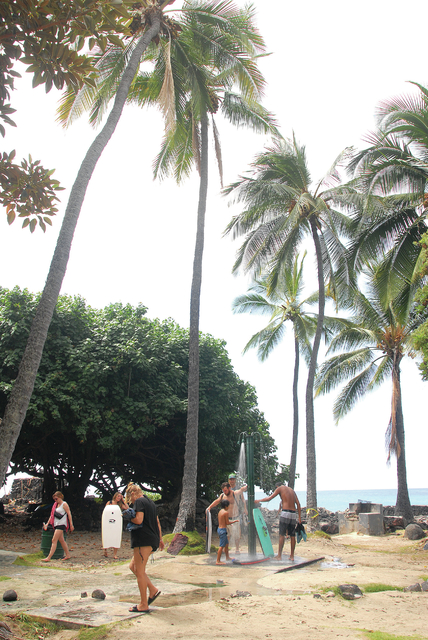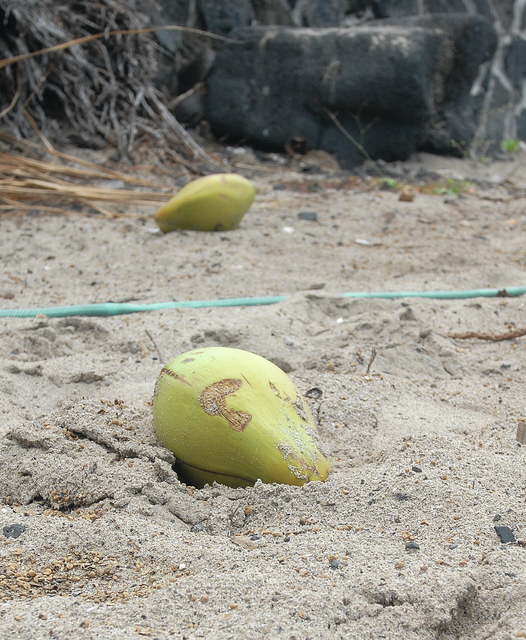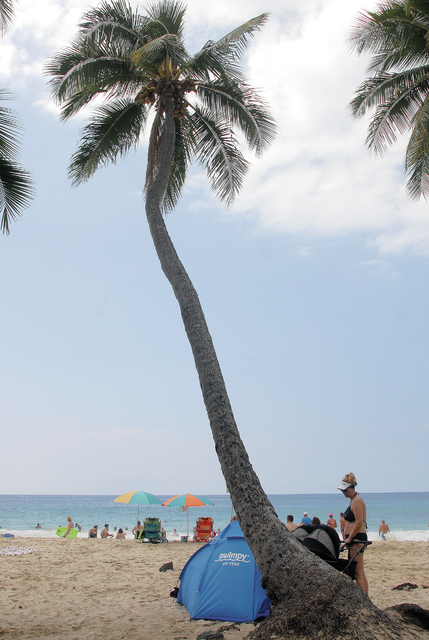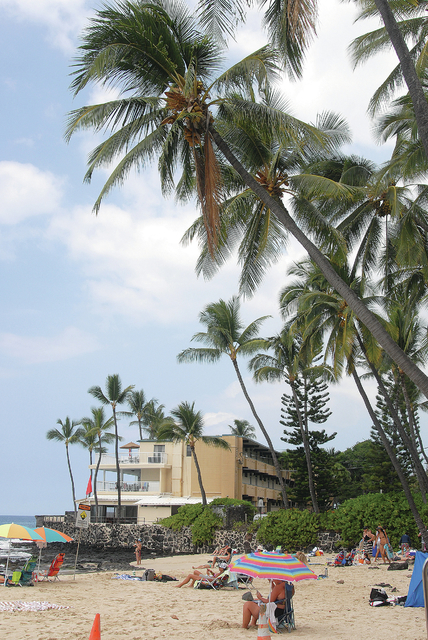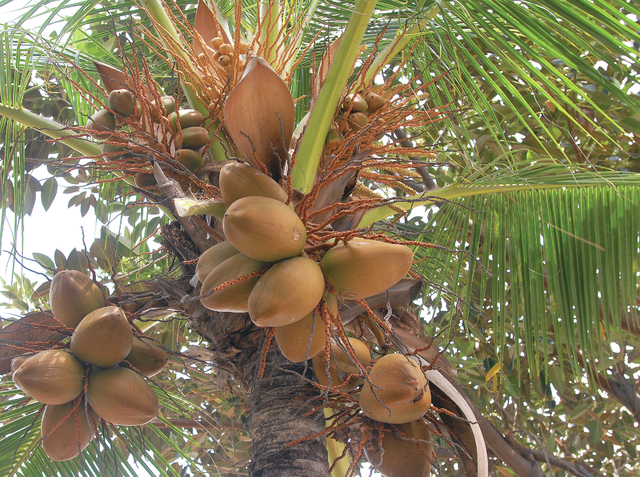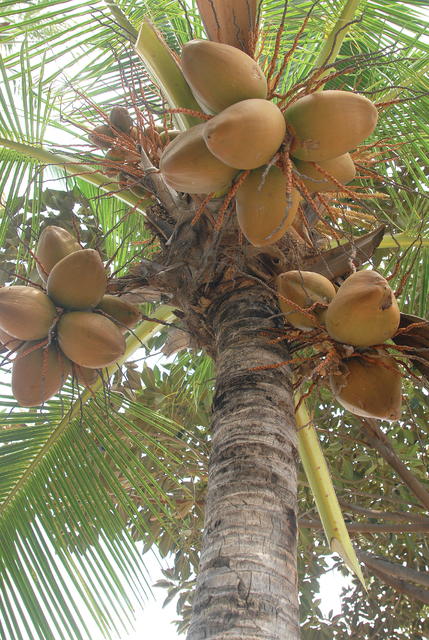KAILUA-KONA — For many, sitting beneath a coconut tree at the beach is the epitome of a tropical vacation.
But at Laaloa Bay Beach Park, also known as Magic Sands, the many coconuts hanging from the beach’s many trees threaten to drop on unsuspecting loungers. The palms here tower over sunbathers, yellowing coconuts hanging overhead. Down below, the coconuts, varying in size, rest here and there, buried in the small craters they created when they hit the sand.
“It seems like a disaster waiting to happen,” said Kona resident Ken Ferrier.
Ferrier said he’s had a small, not-quite-baseball-sized coconut hit him on the shoulder before. Some of the coconuts threatening to fall from the trees at Magic Sands are more imposing.
“Some of those weigh more than 3 pounds,” he said.
A 1984 study that examined injuries caused by falling coconuts said that with trees as high as 79-115 feet tall and coconuts weighing from 2-9 pounds, blows to the head could exceed 1 metric ton of force.
The Hawaii County Department of Parks and Recreation has contracted with someone to trim the trees, said public information officer Jason Armstrong.
“We’ve hired a contractor and expect them to be out there shortly,” he said about Magic Sands. And once the work does begin, he said, they “expect the job to go very quickly.”
Brandon Treloar, also of Kona, said he’s seen some close calls before.
“We’ve had small ones fall down, landed right next to us,” he said, adding that he’ll also warn tourists about the risk.
It’s for that reason he said he’s careful about where he sits when he comes out to the beach.
“We watch where we sit every time,” said the 33-year-old.
For some tourists at the park visiting from off-island, the threat of a coconut looming overhead wasn’t a concern, at least until a West Hawaii Today reporter brought it to their attention on Thursday.
“Now that you mention it, I’m not gonna sit underneath one,” said Ann Slate, visiting from California.
Slate said she never gave any thought to the coconuts, saying she’s more concerned about people taking small children into the shore break.
Swedish visitors Janna Scheele and Jonas Harvard likewise said they hadn’t given much thought to the coconuts among the trees. However once they thought about it, they said it could be an issue.
“Especially if you have babies like we do,” Scheele said, holding a small child.
Harvard said the local government should keep an eye on the trees, particularly during any times when coconuts are more likely to start dropping and take down any loose drupes.
Complicating matters somewhat, he added, is determining exactly how much responsibility the government has in public parks and how much visitors bear for their own safety.
“If it was a private beach, hotel or resort, they would have to make sure no one gets hurt,” he said. “When it’s a public beach, maybe it’s a bit more on you.”
A case could very well be made for the opposite argument, though, Harvard said, suggesting that the government should look out for overall safety.
The issue of falling coconuts might seem a minor one, but Harvard said it could be “a peeking window into a bigger issue,” that issue being how well the local government takes care of safety in public parks and beaches.
He likened it to broken glass strewn across a public walking path, which could cause injury to hikers.
“Should someone have been there sweeping?” he asked.
Overall, he said, trimming coconut palms is “one of many things public authorities could be looking into” to improve safety for tourists and residents alike.
It ultimately comes down to a question of how much risk is involved from sitting underneath a tree at the beach. After all, people don’t naturally want to steer clear of trees at the beach.
“To the contrary, you want to be where there are palms,” he said.
Granted, said Scheele, it would definitely become an issue for somebody once a coconut falls on their head.
“If something were to happen, of course you’d be upset,” she said. “It’s always a non-issue until something happens.”
Treloar said the county needs to be more proactive about trimming the trees and getting the coconuts down before they fall on someone.
The last time trimmers came out, he said, was months ago.
Even then, said Ferrier, trimmers didn’t get to all of the trees.
“It just seems like it could use a bit more attention,” said Treloar.
And given the popularity of Magic Sands, he said, the county ought to prioritize it. Ferrier agreed, citing the importance of keeping visitors safe.
“If tourism is the lifeblood, why funnel them into a deathtrap?” he asked.
Armstrong noted that the department’s tree trimmers have 200 sites to maintain. And while the department can supplement that with contractors, they’re required to follow the procurement process, which also takes time.
He said the department’s trimming schedule follows the coconut trees’ fruiting cycle to stay on top of trimming, but couldn’t say how often trimming actually takes place.
Though he isn’t sure when trimming at Magic Sands will begin, he anticipates it to happen very soon.
In the meantime, he said, staff have set up fencing barricade, which has since mostly disappeared, and cones to discourage beachgoers from gathering beneath trees where coconuts might drop. He added that signs warning about falling coconuts were also put up, though signs couldn’t be seen when West Hawaii Today visited the area.
Armstrong added that he’s unsure if the park will have to be closed when trimming happens, emphasizing that safety is their first priority.
“We would certainly keep it open if we can do so safely,” he said.







